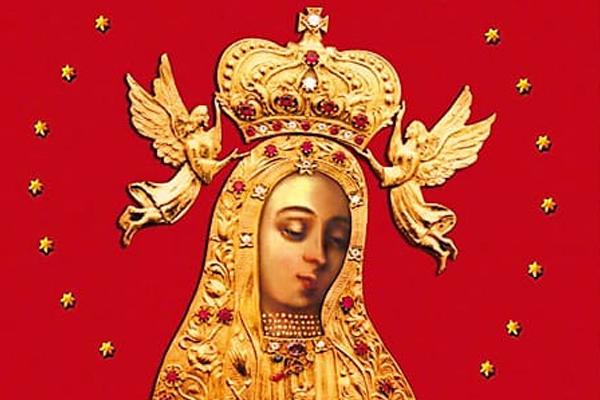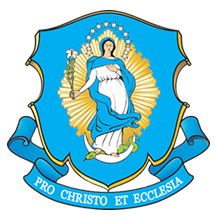
Editor's note: Licheń is the second most frequently visited Marian shrine in Poland, after Czestochowa. The shrine, run by the Marian Fathers and opened in 2004, is the largest in Poland, seventh largest in Europe and 11th in the world. Approximately 1.5 million pilgrims visit the Licheń Shrine annually. July 2 is the Feast of Our Lady of Licheń.
by Stephen J. Binz
The beautiful account of Our Lady of Licheń, the Sorrowful Mother of Poland (feast day: July 2), begins with the story of two visionaries in the 19th century. The first was a Polish soldier, Tomasz Klossowski, one of the horrendous casualties of the bloody battle of Lipsk (Leipzig) in 1813. Gravely injured and lying on the battlefield among the dead, he sought the help of Our Holy Mother and asked her for safe deliverance. He then saw an apparition of Mary, which he described in this way:
She was moving across the battlefield in a long amaranth [rose-colored] dress, floating above the ground and hugging a white eagle at her breast, Virgin Mary! She was slowly coming toward me. She stopped and leant over me and then I saw her face, most beautiful, but full of indescribable sorrow.
She promised that he would recover and return to Poland, and she committed him to search in his homeland for an image most faithfully representing her so that “my nation may pray to it and take graces from my hands in most difficult times.”
Tomasz settled in the village of Izabelin, located near Licheń, and took up his profession as a blacksmith. After many years of searching, he found the small image of the Sorrowful Mother while on a pilgrimage. He brought it to his home, housed it in a small shrine, and hung it on an old pine tree in Grablin Forest.
Call to conversion
After the death of this first visionary, the Sorrowful Mother appeared three times in 1850 to Mikołaj Sikatka, a white-haired shepherd of estate cattle, while he was grazing his herd in Grablin Forest. Because he often prayed at the small shrine hanging in the forest, he recognized the Virgin Mary with her rose-colored dress and the white eagle at her breast.
Through this pious shepherd, Mary called all people to conversion, penance, and prayer in preparation for a coming plague and difficult times. She promised that she would clasp the nation of Poland to her heart as she did with the white eagle.
When a cholera epidemic broke out in 1852, the ill and endangered people of the nearby villages began to gather at the apparition site and the small shrine in the forest. As health and graces were experienced by the local people, a chapel was built in the forest for the image. As devotion to the Sorrowful Mother continued to grow more widely, the miraculous image was brought to the parish church in Licheń.

The elements of her attire are dominated by two guiding themes: the royal dignity of Mary and the consideration of her Son’s Passion. The first is expressed by a crown, held up by angels. The sign of the white eagle, the emblem of Poland, indicates that Mary is the Queen Mother of her Son’s realm.
The second theme is expressed by her sorrowful expression and the symbols of Christ’s Passion on each side of the robe that flows down from her shoulders. Symbols of the Passion include nails, thorns, a spear, cross, whips, a sacrificial lamb, a rooster, a ladder, and a chalice. Our Sorrowful Queen knows the suffering of her children.
Marian basilica
The image was housed at the main altar of the Church of St. Dorothy, until in 2006 it was solemnly transferred to the new Basilica of Our Lady of Licheń, Poland’s largest church, built by the Marian Fathers. Today it is honored at the central altar, above the tabernacle, with the papal crown above it, surrounded in royal red and contained in a richly decorated golden frame. High above the image, at the level of the columns’ capitals, are the words Jestem który Jestem (“I Am Who I Am”), from Exodus 3:14. Below are the words of the oldest Polish Marian hymn, Bogurodzica.

There are 33 steps leading to the church, referring to the years of Jesus Christ’s life on earth. The basilica has 365 windows and 52 doors, which symbolize the days and weeks of the calendar year. The large windows are made of amber-colored glass, divided with aluminum slats in such a way that the windows resemble ears of grain. The sun’s rays create a unique play of colors within the church.
The remarkable organ, the largest in Poland, saturates the basilica with sound. It consists of three separate instruments located in the west and east aisles and in the main choir, containing a total of over 12,000 pipes.
Our Lady of Licheń, pray for us!
Excerpted from The Way of Mercy: Pilgrimage in Catholic Poland by Stephen J. Binz, published by Marian Press.
















